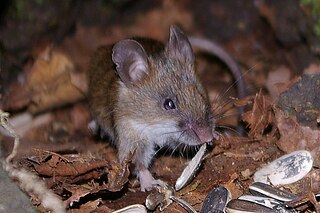
The gray leaf-eared mouse is a rodent species from South America. It is found in Argentina, Bolivia, Brazil and Paraguay; its habitat includes the Gran Chaco.
Handleyomys fuscatus, also known as the dusky-footed Handley's mouse or dusky-footed montane mouse, is a species of rodent in the tribe Oryzomyini of family Cricetidae. It was previously placed in the genus Aepeomys, but it is closely similar to Handleyomys intectus, and accordingly both species were placed in the new genus Handleyomys in 2002. It is found only in Colombia.
The Chaco grass mouse is a species of rodent in the family Cricetidae. It is found in Argentina, Bolivia, and Paraguay.
Olrog's chaco mouse is a species of South American rodent in the family Cricetidae, endemic to Argentina. The natural habitat of the species is hot deserts. Its karyotype has 2n = 60. The species is named after Swedish-Argentine biologist Claes C. Olrog.
Andalgalomys is a genus of rodent in the family Cricetidae. It contains the following species:
Pearson's chaco mouse is a species of rodent in the family Cricetidae. This mouse is found in the Gran Chaco ecoregion of southeastern Bolivia and western Paraguay at elevations up to 400 m. The species is named after American zoologist Oliver Payne Pearson. Its karyotype has 2n = 76 and 78 in the two subspecies. The latter is the highest diploid number of any species in the tribe Phyllotini.

The small Japanese field mouse is a species of rodent in the family Muridae. It is endemic to Japan, spanning from Hokkaido to Kyushu and is similar to its larger counterpart, Apodemus speciosus.
Chevrier's field mouse is a species of rodent in the family Muridae. It is found only in China.
The Kashmir field mouse is a species of rodent in the family Muridae. It is found in India, Nepal, and Pakistan.

The Taiwan field mouse, also called Formosan wood mouse, is a species of rodent in the family Muridae. It is found only in Taiwan.

The least forest mouse is a species of rodent in the family Muridae. It is found only in the Philippines.
The Awash multimammate mouse or Awash mastomys is a species of rodent in the family Muridae found only in Ethiopia. Phylogentically the Awash multimammate mouse is the sister taxon of the Natal multimammate mouse, a species found almost everywhere in Africa south of the Sahara and considered a serious agricultural pest throughout its range.
The delectable soft-furred mouse or East African praomys is a species of rodent in the family Muridae. It is the only member of the genus Montemys; it was formerly classified in the genus Praomys.

Alston's brown mouse, also called Alston's singing mouse, short-tailed singing mouse, or singing mouse, is a species of rodent in the family Cricetidae. It is found in Central America, from Chiapas, Mexico, to western Panama.
Zygodontomys brunneus, also known as the brown zygodont, brown cane mouse, or Colombian cane mouse, is a rodent species in the genus Zygodontomys of tribe Oryzomyini. It is found only in Colombia.
Roig's tuco-tuco is a species of rodent in the family Ctenomyidae. It is endemic to a small region near the Paraná River in Corrientes Province, northeastern Argentina, where lives on sand dunes, and near rivers. Development is degrading and shrinking this habitat, threatening the rodent's survival. The species is named after Argentine zoologist Virgilio G. Roig. Its karyotype has 2n = 48 and FN = 80.
The Paraguayan bolo mouse or Paraguayan akodont is a species of rodent in the family Cricetidae. According to the IUCN, it is present in Bolivia, Paraguay, and Peru, and possibly also in Argentina and Brazil. It is found at elevations from 300 to 2,030 m in a variety of habitats, including cerrado, chaco, and heath pampas.
The delicate salt flat mouse is a sigmodontine rodent species in the family Cricetidae from South America. It is the only species in the genus Salinomys. Its habitat is scrublands bordering salt flats in the Monte Desert area of central western Argentina at elevations around 400 m. The closest relatives of the species are the chaco mice (Andalgalomys).
Bibimys chacoensis is a species of small rodent of the family Cricetidae living in the north-central part of Southern Cone of South America. The common name of this species is Chaco crimson-nosed rat. It is one of the three species currently recognized under the genus Bibimys.




